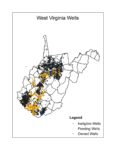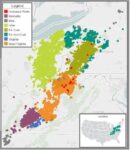This article originally provided by Penn State Live
Greg Grieco, Penn State Public Information
University Park, Pa. – Natural gas distributed throughout the Marcellus black shale in northern Appalachia could conservatively boost proven U.S. reserves by trillions of cubic feet if gas production companies employ horizontal drilling techniques, according to a Penn State and State University of New York, Fredonia, team.
“The value of this science could increment the net worth of U.S. energy resources by a trillion dollars, plus or minus billions,” said Terry Engelder, professor of geosciences, at Penn State.
The Marcellus shale runs from the southern tier of New York, through the western portion of Pennsylvania into the eastern half of Ohio and through West Virginia. In Pennsylvania, the formation extends from the Appalachian plateau into the western valley and ridge. This area has produced natural gas for years, but the Marcellus shale, a deep layer of rock, is officially identified as holding a relatively small amount of proven or potential reserves. However, many gas production companies are now interested in the Marcellus.
Engelder, working with Gary Lash, professor of geoscience, SUNY Fredonia, has conservatively estimated that the Marcellus shale contains 168 trillion cubic feet of natural gas in place and optimistically suggests that the amounts could be as high as 516 trillion cubic feet.
“Conservatively, we generally only consider 10 percent of gas in place as a potential resource,” said Engelder. “The key, of course, is that the Marcellus is more easily produced by horizontal drilling across fractures, and until recently, gas production companies seemed unaware of the presence of the natural fractures necessary for magnifying the success of horizontal drilling in the Marcellus.”
The U.S. currently produces roughly 30 trillion cubic feet of gas a year, and these numbers are dropping. According to Engelder, the technology exists to recover 50 trillion cubic feet of gas from the Marcellus, thus keeping the U.S. production up. If this recovery is realized, the Marcellus reservoir would be considered a Super Giant gas field.
Engelder, who has studied this area of the U.S. for most of his career and began looking into fractures under a National Science Foundation grant 25 years ago, has identified and mapped natural fractures in the Marcellus shale. He and Lash will present some of their recent work at the 2008 American Association of Petroleum Geologists Annual Convention and Exhibition this spring.
The researchers look at the patterns of fractures in the shale and determine which are important for gas production. Fractures that correlate with the folding of the ridge and valley system are less common in black shale. However, because of their orientation, the fractures that formed prior to the folding will release gas if the wells cross the fracture zones.
These fractures, referred to as J1 fractures by Engelder and Lash, run as slices from the northeast to the southwest in the Marcellus shale and are fairly close together. While a vertical well may cross one of these fractures and other less productive fractures, a horizontally drilled well aimed to the north northwest will cross a series of very productive J1 fractures.
“It takes $800,000 to drill a vertical well in the Marcellus, but it takes $3 million to drill a horizontal well,” said Engelder.
Companies that drill gas wells need to be certain that horizontal drilling will produce the gas they expect, and the work by Engelder and Lash suggests that it will.
“We know that the Marcellus shale appears as an outcrop near Batavia, N.Y., east of Buffalo,” said Engelder. “And we can see the fractures in the Marcellus in the exposed sections of the ridge and valley areas to the southeast. Because we see them going through the folded areas, we know they were there before the folding. If it happened earlier, then we know they have to be in the intervening basin as well.”
The natural fractures in the Marcellus shale are the key to recovering large amounts of gas. As heavily organic sediments were laid down 365 million years ago, the black shale of the Marcellus formed. As the organic material decayed and degraded, methane and other components of natural gas formed and dispersed through the pores in the rock. About 300 million years ago, the pressure of the gas caused fractures to form in the shale. It was not until 280 million years ago that the eastern portion of Pennsylvania was pushed into the folding of the ridge and valley province that makes up that area. Gas that occurs in pockets underground is considered a conventional reservoir; gas that is distributed throughout the rock, like the Marcellus, is called an unconventional reservoir.
The Penn State-Fredonia approach is not restricted to production of the Marcellus shale, but can be applied to any gas-bearing shale with this type of fracture. Because the approach begins with a vertical well and then drills horizontally in the direction that will crosscut the productive fractures, old vertical wells can be reused.
“We can go back to wells that are already drilled and played out, and then drill horizontal from there,” said Engelder. “Reusing old wells has both economic and environmental value.”
Engelder and Lash are principals in Appalachian Fracture Systems Inc., a consulting firm.










